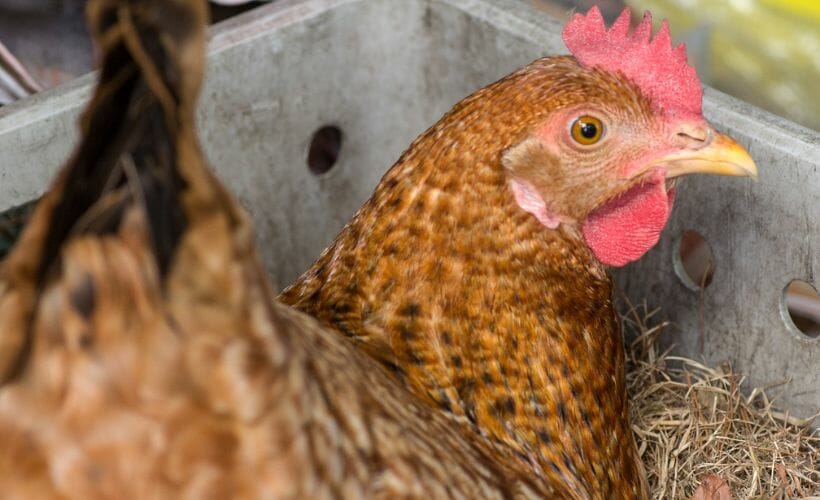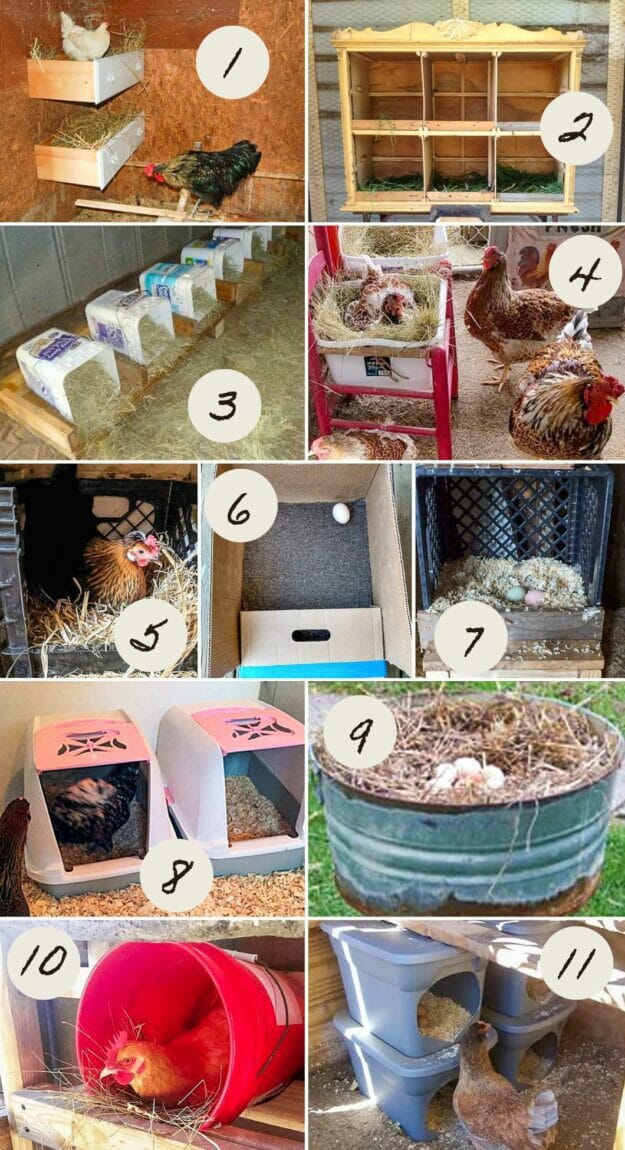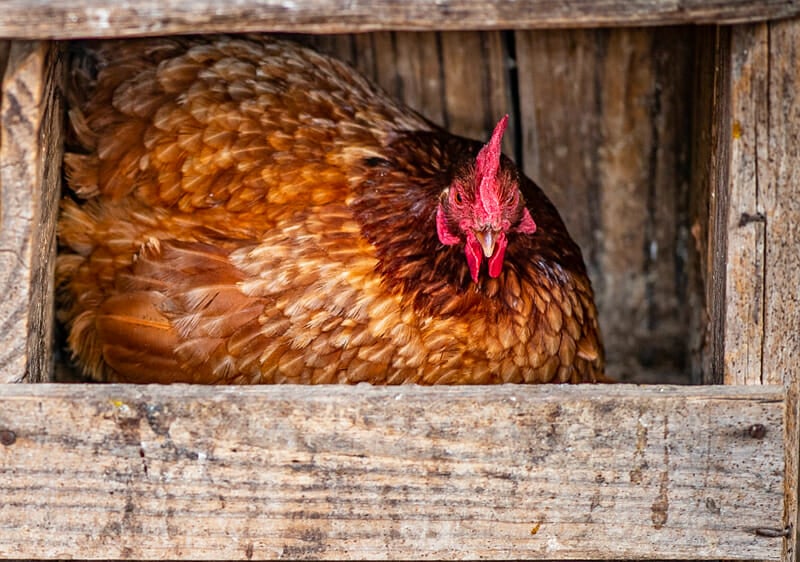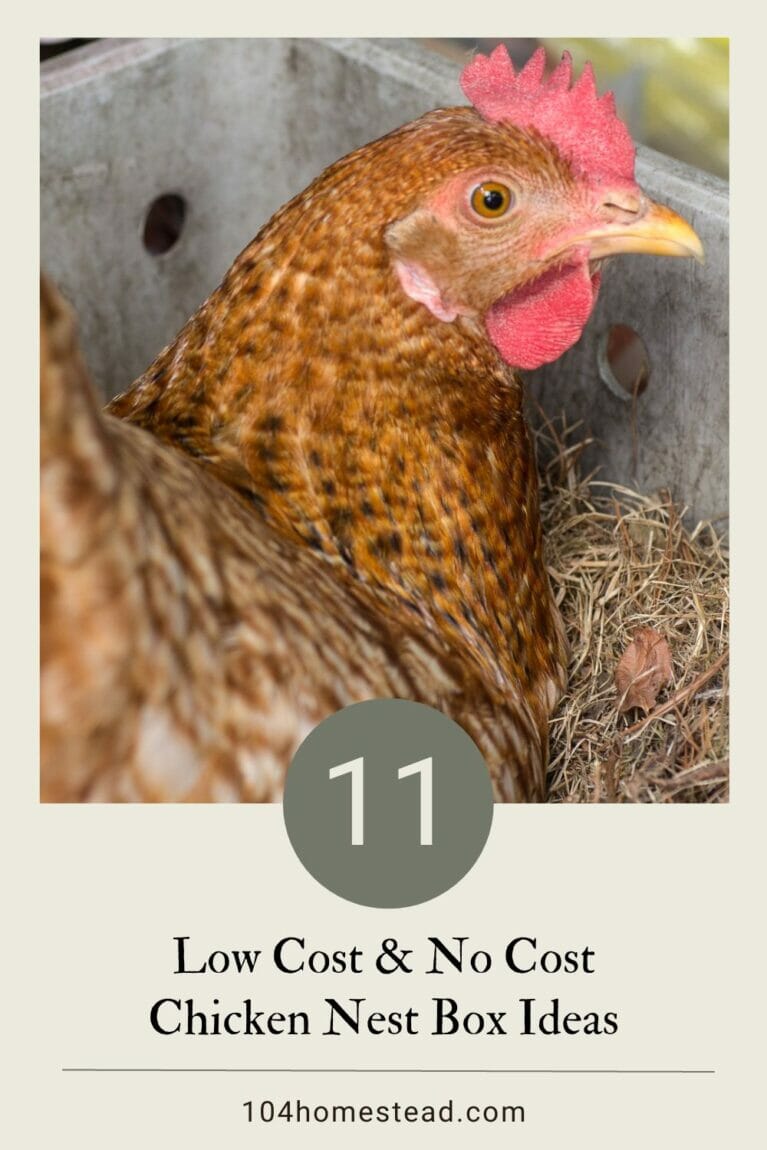11 Low & No Cost Chicken Nest Boxes (+ Nesting Box Tips)
Chicken nest boxes don’t have to be expensive. Try these easy and inexpensive DIY nest boxes that can be put in place in minutes.

If you’ve got a flock of birds for egg-laying purposes, you may need to consider getting nest boxes. Chickens will lay in anything that seems cozy. Turkeys will typically use a nest box. Guinea hens tend to prefer open-topped boxes at floor level in a secluded corner. Quail can be encouraged to lay their eggs in an open nest box with a sand substrate. If you’ve got ducks… forget about it.
I have heard stories of ducks using nest boxes, but they must be some sort of urban legend. My ducks have created a fun game of laying in the oddest places and then changing locations when I finally figure out where. Some famous laying locations for my ducks:
- On top of the woodpile inside a little dip in the tarp.
- On the BBQ grill shelf.
- Balanced on the top of the 5-gallon nipple waterer.
- On the roof of the little coop.
If those locations aren’t strange enough on their own, it’s worth mentioning that these are big, fat, non-flying birds. How they get to these locations is beyond me. I felt it was a colossal joke at my expense for a while. Then I realized that my children wouldn’t get up before me and move eggs for this long of a time.
Buying or Building Chicken Nesting Boxes
Anyways, back to the topic at hand. Nest boxes. You can buy a variety of nest boxes either online or at a farm supply store. Tractor Supply has a wide variety, but they start at $18, which can add up quickly.
There are many cheap options for good nesting boxes you can get at your local Wal-Mart or Dollar Store. There are even some free options using materials or items you probably have kicking around or can find on Marketplace.
Raising Happy Chickens assesses the best material for your chickens’ nest boxes with pros and cons for each material.
“Cheep” and Free Nest Box Ideas
These boxes will work for any kind of poultry. Remember that nest boxes should have enough space for a hen to enter and sit comfortably, but not so big that two hens can squeeze in together unless it’s an open-concept box. Larger breeds will need larger boxes.

1. Dresser Drawers
How often do you see a dilapidated old chest of drawers on the side of the road? Those drawers make an excellent communal egg box.
2. Upcycled Furniture
You can utilize all sorts of furniture for nest boxes, but this bookcase box set from My Creative Days is just so… well… creative!
3. Kitty Litter Buckets
It is always important to utilize all your resources. Usually, a simple solution to your needs can be found quite easily if you spend a little time looking in the right place. Check out this tutorial from Stealth Survival that utilizes kitty litter buckets.
4. Dish Pans
This nest box made from a single dish tub and an old chair from Chicken Heaven on Earth is so cute!
5. Old Milk Crates Positioned Upright
Milk crates themselves make the perfect box for two main reasons (besides the chicken appeal): one they’re easily portable, two they’re absolutely the easiest thing to clean. These ones from Wild Groves Farmstead are stackable because they are not used on their sides.
6. Cardboard Boxes
This is a great disposable/compostable option that seems really popular on Backyard Chickens. Bankers’ boxes are very sturdy and will hold up for quite a while.
Asheville Farm Tips and Ideas has created a roll away box with cardboard which is pretty impressive.
7. Milkcrates on Their Sides
Do you need an extra nest box and are in a hurry? Here’s a perfect solution: make a nest box out of a milk crate. It’s a perfect size and only takes a couple of minutes. City Girl Farming shows you how.
8. Covered Litter Boxes
Farming My Backyard discovered that covered litter boxes are amazing not only for her chickens but for her rabbits as well. The covers provide the privacy many chickens may desire without the need for curtains – a concept I tried and quickly abandoned. Curtains in a chicken coop are for magazine shoots only lol.
9. Metal Washing Bins
This is my personal favorite and sometimes even the ducks will use these bins. They are incredibly deep, so you can layer the bedding to make it nice and soft. I line my wash bin nest boxes to the halfway point with sawdust and then top it with wood shavings. I just scatter them around the floor of the coop along the coop walls where the chickens already decided they want to lay.
10. Drywall Buckets
5-gallon buckets can make excellent nesting boxes for your flock, not to mention they are budget-friendly. Meyer Hatchery has a tutorial on how to utilize them. Because they are plastic, the poop can easily be washed off them.
11. Storage Totes
Can I just say that What the Flock Farm is such a fun homestead name? Anyways, here’s a video of a great storage tote box.
BONUS 12. Plywood Boxes
Matt’s Finds threw together boxes for his laying hens utilizing scrap plywood left over from other projects.
Chicken Nest Box Tips & Tricks
The Size of the Box
The general rule here is the bigger the bird, the bigger the box. A bantam hen could easily use a small 9″ x 9″ box. A turkey will need a large 18″ x 18″ box. The nesting area does not need to be a series of individual boxes. Some birds enjoy using communal boxes (others however do not). My setup includes one large communal box that is 30″ x 18″ x 18″ and three individual boxes that measure 18″ x 18″ x 18″. If I have a hen that goes broody, she gets put in the communal box and gated off so no one bothers her. This is a good amount of space for her to keep her chicks the first few days after hatch before she is released back to the general population.
How many nesting boxes per chicken?
Too few nest boxes lead to unhappy hens. Too many nest boxes lead to inefficiency and squabbling.
The general rule of thumb is one nest box for every 3-4 hens. This is a guideline and like any good guideline, it’s a number to get you started. I start on the low side and see how my birds interact. If they are forming a line and yelling at one another every morning it’s time for more boxes. Crowded boxes mean I might want to consider adding another communal box. If I have three boxes on top that never get used, but three on the bottom are stuffed with birds, I could take the top three and put them at floor level. Movable boxes are a great idea.

What is the best material to use in nesting boxes?
You can line your nest boxes with just about anything. I enjoy giving my birds variety. Happy hens lay lots of eggs. Some options include:
- Shredded newspaper
- Pine shavings
- Hay or straw
- Sand
- Pine needles
- Grass clippings
- Commercial liners
Think of the animal that will be using the box when considering what to line it with. You don’t want a wet duck nesting in the shredded newspaper.
Is it OK for chickens to sleep in the nest box?
Letting your chickens roost in the nesting boxes is a bad habit that should be prevented and remedied as soon as possible. Chickens sleeping in nesting boxes run the risk of breaking and eating their own eggs.
Crystal Long has a great article on 7 reasons why this happens and how to stop this unwanted behavior.
How high should chicken nesting boxes be? Should the roost be above the nesting box?
Many people will say that the height of the nest box should be no less than 18 inches from the floor and can be as high as a few feet off the ground. I, personally, have had them directly on the ground with no trouble at all.
They should, however, be lower than the roosting bars. Chickens like to sleep as high up as possible. If the nest boxes are as high or higher than the perches, they will sleep in or on the boxes. This will definitely lead to poopy eggs and other unpleasantness (like egg eating).
How do you train a chicken to lay eggs in a box?
We’ve always had luck using golf balls or fake eggs.
Create an ideal place for your chicken to live. One important factor is the choice of bedding. Learn why your chickens will love sand as bedding. Find out the most important things you need to do to build the perfect coop so that your nest boxes are part of a useful living space for your birds. Add chicken-safe plants to their environment that are both beautiful and useful for them, like keeping pests away and giving them extra nutrition.
If you’ve found value in this blog post and enjoyed reading it, why not share it with your Pinterest community? Pin the image below and spread the love!

These nest box hacks are useful ways to solve common problems with keeping chickens, which will make your hens happier and help them lay more eggs. You can make your coop easier to clean, easier to maintain, and a more comfortable place for your feathered friends by using these simple but useful tips. Whether you have been a homesteader for a long time or are just starting out, these tips will help you run your coop better.
What do you use for your nest boxes? What do you line your nest boxes with? Share in the comments below. And be sure to check out Backyard Chickens 101: Everything You Need to Know About Laying Hens.

I have somewhat of a crazy question 🙂
I’m a dog groomer. Can I use dog hair as bedding. Since the dogs are always bathed and dried before the groom the hair is clean.
I don’t see why you couldn’t. Might as well give it a try. If it works well, be sure to report back.
We got ahold of a old shelf and cut the top off. Next we put in 4 plastic bins purchased at IKEA. Since we just acquired 4 more chicks that will be joining our two other Hens it should be interesting to see how it all works out. We plan to keep the new chicks confined in a child’s play pen until the older Hens and they get acquainted.
All of our ducks lay in nesti boxes
They grew up with the chickens and they don’t think about doing it different.lol
I should update this post to say that my Khaki Campbells get the whole “nest box” concept, but there is no hope for the Swedish Blues.
What do you consider the best nesting material in a coop with a sand floor?
I like to use things like hay or straw. I find that they don’t get mixed in like shavings do. My ducks actually prefer to make nests in the sand. Often the chickens will utilize the sand nests the ducks have created.
I love all these clever ideas! We use a recycling bin from our trash service! It is the perfect size and I love that we can hose it out if it gets nasty. Pinned this one!
How do i secure the plastic totes to the boards they st on
When we had ducks, they all laid their eggs in the same little nest for months. I’ve been told that the best way to get all your ducks to lay in a reliable place is to keep them shut in their coop until about 8 or 9 in the morning. If we let them out earlier, they’d lay in their yard. It sounds like you free range your ducks, so, no telling if they come to a shut-able coop to lay in, but there’s my 2 cents.
Great tip Bonnie. In the winter my ladies choose to come in with the chickens at night to stay warm. Eggs are easy to find then. In the winter, however, they prefer to sleep in the great outdoors. I guess I can say it’s great exercise for the kids running around and trying to find them all. The highlight is that unless they are molesting, my Blue Swedish lay every single day, so you know how many you’re looking for.
I like the looks of that old desk upcycle. 🙂 I have three nest boxes I built out of plywood but they’re all one unit.
Wish I would’ve thought up front to have them each be independent and portable. That way I could move a broody hen without ever making her leave the nest.
Hindsight is 20/20 which is why I am constantly redoing and modifying what I have.